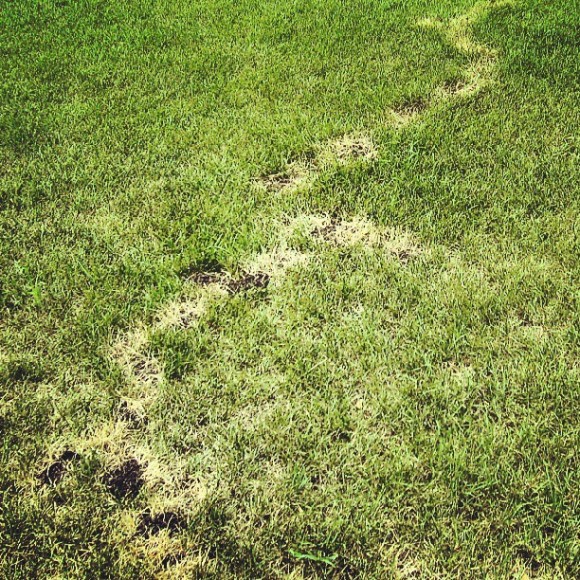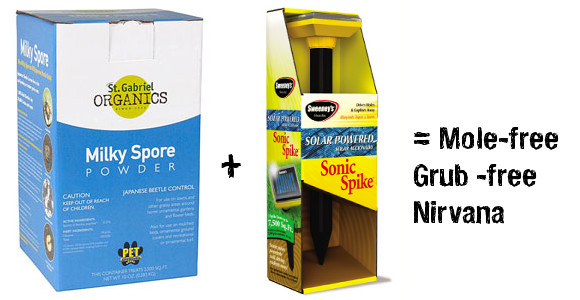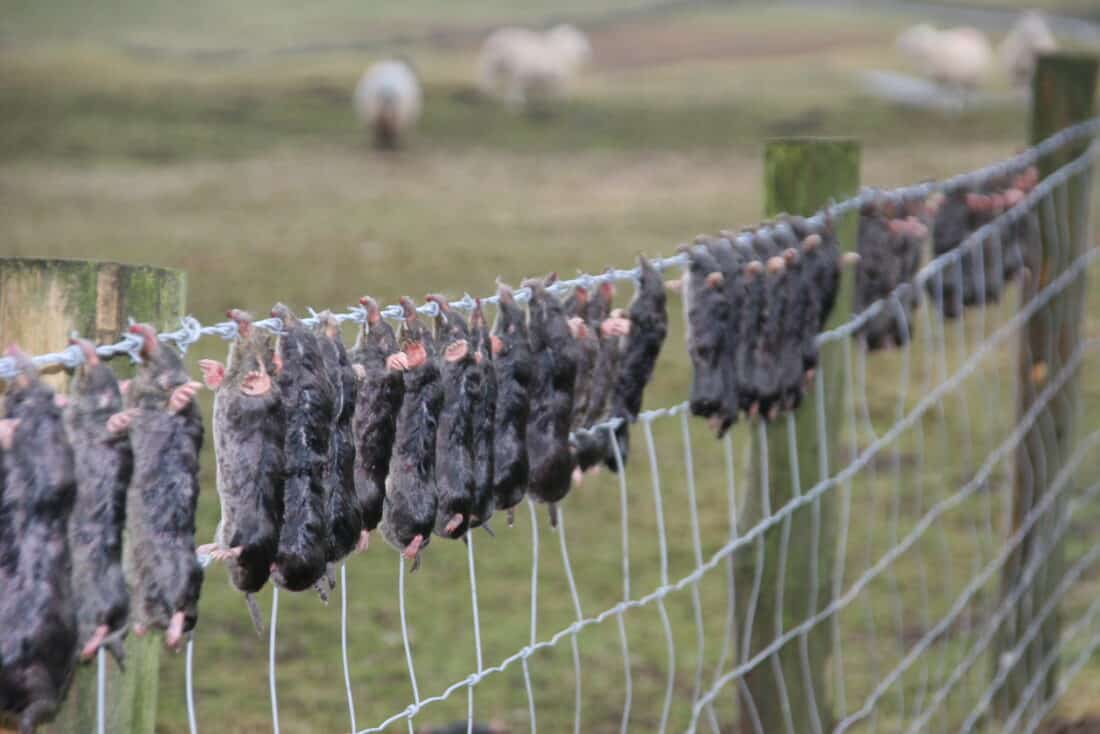I’ve got moles, lawn grubs, and Japanese beetles, and I have to admit I feel a little silly that it has taken me so long to sort them out.
I’ll start at the beginning. Two springs ago, my front lawn didn’t come back and green up after the winter. Not only was it completely dead, but it felt funny to walk over (weirdly squishy and slippy at the same time).
What The Heck!? I dug and really didn’t see anything until I dug at the edges of the deadness. Grubs – lots of them!
I was in a bit of denial, though, because, to be honest, I’ve seen greater infestations with less damage, so I surmised that something else must be going on. I thought it was a soil problem, and I added organic matter to my soil, thinking it would revive the green lawn… but to no avail. My dead patches of grass weren’t just stressed turf – they were truly dead (as in stick a fork in it – done!)
I had a serious grub and mole problem…bad.
Identifying a Grub Problem
Grubs eat grass roots, and when you have a serious grub infestation like I do, you will see significant damage to the grass. In my case, there was hardly a square foot of healthy lawn. Once the roots of your grass are gone, not only will your entire lawn turn brown (with no recovery), but you might also begin to feel a strange squishiness underfoot that indicates that you might have an even bigger problem – moles who are digging tunnels to eat the grubs. (yes, moles eat grubs and beetles)
Right now, the whole marauding hoard of underground pests has begun to move to the lawn area on the other side of the driveway, but this time, it is more obvious what is going on. Not only do I have a sweeping army of Japanese beetle grubs, but they are attracting a herd of moles that are enjoying the grub feast.
Is there a natural balance between moles and grubs?
My first thought was that my problem might be solved in a natural way…
The logic: moles eat grubs, grubs go away, then moles go away?? Maybe?
With this theory in mind, I’ve observed for yet another season. While moles do eat grubs – they aren’t eating them all. And the idea that my problem would solve itself, well, that didn’t work either, and in the meantime, I’ve got a lawn that looks like this. (brown patches and trails everywhere!)

I twisted my ankle in a mole hole last week, and now my patience for natural methods to take over is over. And so, too, is my penchant for scientific observation (nearly breaking my ankle makes me lose patience for lots of things).
Using Milky Spore Powder for Grub and Mole Control
I bought milky spore powder, and I applied it as described in the package. Spoonfuls every 4 ft in a grid. And for extra measure, I put down a few Solar Powered Mole and Gopher Sonic Spikes.
Milky spore powder is a bacteria that only impacts Japanese Beetles (for which the grubs are the larvae). It is organic and does not harm beneficial insects or leave anything to harm you, your kids, pets, or the environment. I love that kind of garden solution.
Milky Spore powder prevents the Japanese beetle larvae (which are many of the grubs you might be seeing in your soil) from maturing by infecting them with the spores of the bacterium Paenibacillus popilliae (bacillus popilliae). This matures in their bodies, giving them milky spore disease (or milky disease) and preventing them from advancing past the larval stage and becoming beetles.
I am planning to treat once now (it is late summer) and then again in the early fall since that is when grubs eat the most. Once the spore is in their system, it will infect generations of grubs to come (at least, that is the theory).
So by next spring, I should see a huge improvement not just in my grass with fewer grubs but also to have fewer Japanese beetles eating my trees and fewer moles digging everything up.

While I wait to have this ecological cycle broken (it can take a couple of years), I am thinking that the Solar Powered Mole and Gopher spike is doing something good in the short term.
I haven’t seen a new mole trail since I put it in.
I am hoping that it will also bug the daylights out of whatever is eating the roots of my hostas. (is it possible I also have a vole problem too?!?)

(UPDATE May 2021)
Yes, I also have a vole and a woodchuck problem.
I am trying to drive away the woodchuck by being an absolute menace to his existence. I’m hoping a new dog might maybe, just maybe, it will be the last straw for the woodchuck family that lives under the chicken coop?🤞
I’ve done everything else I can think to make it an unpleasant place to live. I am hoping they will soon tire of my nuisance, but I am not holding my breath.
I have exposed their entryways so that there is less protection as they leave their lair. Additionally, I spread used kitty litter everywhere. As well as fox pee too.
I have generally hung around the shed a lot, personally, so my own smell is all over it. And I have encouraged the dog to shove his whole face in their hovel at every possible opportunity.
As for the voles, I have tried the castor oil in their holes (to no avail) and spread kitty litter where they live too. I am not sure either is having any impact. I still struggle with voles – though their destruction waxes and wanes, and I am not sure I fully understand why yet. I’m working on this issue.
This post was originally written in 2013, and the milky spore powder solution applied back then worked very well in my garden (though not 100% – I’d estimate around 85-90%) for easily 7-8 years and until now.
It is 2021 now, and I’ve seen a slow increase (though still nowhere near the levels prior to my first application) in grub and mole activity over the last few years, so I am planning another application this year. I have not, however, seen any return of the Japanese beetles – those have remained at bay permanently.

(UPDATE July 2023)
The milky spore power application from a decade ago has continued to keep adult beetles from being a problem in my garden. I do, however, still have a grub worm problem. (presumably of other species of beetle) These are continuing to support many more moles than I would prefer.
I have not yet tried beneficial nematodes, and this is my newest strategy for dealing with the ongoing grub problem.
(this is the product that I am trying, but these types of grub control products are widely available at garden centers).
Beneficial nematodes are microscopic worms that are dispersed in water (through a sprayer). Heterorhabditis bacteriophora (beneficial nematodes) will (like the milky spore powder) infest the white grubs and kill them in their larval stage.
If you are reading this in the early spring or early summer – it is the right time to start planning a beneficial nematodes treatment in your garden. They need soil temperatures above 70 degrees Fahrenheit to complete their lifecycle reliably. (Which includes embedding themselves inside the bodies of the white grub worms). 😬
You may need to treat areas of your lawn that continue to have signs of grub damage with multiple treatments that are timed about seven days apart.
Once you have reduced a large infestation, you can continue to use beneficial nematodes as a preventative treatment.
How do you know if you have moles or voles?
Voles are Vegetarians; Moles eat Meat. See what I did there? V-V and M-M (this is how I remember which are which). And by meat, I mean grubs.
Vegetarians (Voles) eat roots and kill plants from the bottom up. You’ll notice one day that a healthy plant is suddenly falling over, and you might want to straighten it, but when you touch it, it will just come right out of the ground – because it has no roots.
What hasn’t worked for the voles? So far, I’ve spent a dear few dollars on castor oil, and I’ve also spread a good amount of dirty cat litter over the vole holes. I can’t tell if any of it is doing any good – I don’t think it is. I’m still losing whole shrubs over the winters. I’ll update this again if I find a good solution.
The woodchuck no longer lives under the shed – he has upgraded, copulated (profusely -extending his empire), and now lives with his large family under the much bigger barn. We are still butting heads and trying to come to a truce.
+comments+